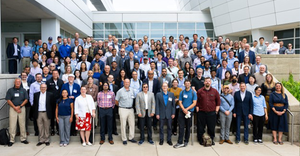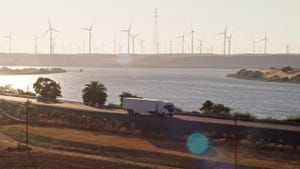LIKE A GOOD NEIGHBOR 1800
April 1, 2005
Kim A. O'Connell
THE WASTE INDUSTRY CAN be an anonymous profession. After putting trash out at the curb, residents rarely think about the people hauling away the contents of the cans, much less the managers in the back office or at the landfill. So it can be a surprise when waste workers get recognized.
Recently, Dennis Hobbs, director of special projects for Austin-based Texas Disposal Systems (TDS), was standing in line at the grocery store, minding his own business, when a woman suddenly exclaimed and pointed to the TDS logo on his T-shirt. On a school trip, the woman's child had visited and raved about the TDS facility, which includes a community center and ranch with dozens of animal species. With several shoppers listening, the woman loudly thanked Hobbs for being a good corporate neighbor. “I couldn't buy that kind of publicity,” Hobbs says.
Like many other waste companies and government departments, TDS has made community outreach a priority. Community education benefits waste operations in several ways. In addition to boosting local and regional name recognition, maintaining a high profile ensures that waste operations remain accountable to the communities they serve. The result often means that facilities are as safe, environmentally sound and economically efficient as possible.
Corporate Stewardship
After launching the company in the late 1970s, TDS Owner Bob Gregory sought to set his company apart from other industry players by taking a keen interest in the community. When TDS sought a permit to build its landfill in the 1980s, it worked to address the concerns of local environmental groups, government officials and citizens. Also, TDS ensured that the landfill would encompass only about a third of a 1,000-acre tract. The rest would be used as community pasturelands for cattle, buffalo, deer, ostriches, emus and other wildlife.
In 2004, Hobbs says, more than 15,000 people came through the landfill site to get to the community facility. “We get some customers this way, but we [host community events] because it's the right thing to do,” he says. “Even if there's no financial benefit, we're recognized for being a good steward and citizen.”
Houston-based Waste Management Inc. (WM) used community outreach programs to ease the way for a recent landfill expansion in Texas. WM, like nearly every other major waste company, has faced its share of resistance whenever it has wanted to build or expand a new facility. But because the company's Southeast Texas Landfills division had a longstanding relationship with the community, local acceptance of the expansion was greater than it could have been.
“Community outreach played extremely positively into it,” says Lisa Doughty, community relations manager for the division. “When we went to the community, [citizens] were more informed and educated. There was an understanding about what a landfill is, and there wasn't that knee-jerk reaction of ‘We don't want it.’”
On a national level, WM has developed several environmental education programs that can be tailored to a particular community's needs. These include “The Story of Garbage,” a history program that is given in schools, as well as an “Earth Savers” family education program. WM has worked with other organizations to develop curricula and outreach materials, including posters about the anatomy of a landfill and recycling guides.
“It's not just about educating the students — we also want them to come home and educate their parents,” says Debbie Figueras-Cano, community relations manager. “Environmental stewardship is one of Waste Management's responsibilities. But the reality is that we can't do it all alone. We have to work with the community on that effort.”
WM's national office helps its field teams to reach out to local school districts and other community groups to determine their needs. In San Antonio, for example, company officials hosted a major golf tournament to raise funds for local students. The company's American Landfill in Ohio gave a renewable college scholarship to a local high school student. In Florida, students participated in a competition to design posters on environmental stewardship. The winning design was blown up and hung on the side of a garbage truck. “It builds morale for our employees, and it makes them feel proud of being part of this company,” Figueras-Cano says. “It helps us a lot when it comes to the community.”
Outdoor Classrooms
In southeast Texas, Doughty has tailored outreach programs to each of the communities surrounding her division's nine landfills. In one location, she estimates that the company has about 4,000 neighbors within a 1-mile radius. To reach out to residents, Doughty attends monthly homeowner meetings, gives presentations to civic leaders and offers two open houses per year at the division's largest landfills. During the open houses, she asks visitors to fill out a short questionnaire, soliciting their concerns and comments about the facility. “People fear the unknown,” she says. “If you can get them in and show them what's happening, they come away with a whole different perspective.”
Children are a natural audience. Consequently, Doughty has worked with a local education foundation to establish grants for local teachers seeking innovative ways to teach science. One grant funded a portable planetarium called Starlab for elementary and middle school students. Other children have built edible landfills, with graham cracker crusts serving as clay liners, licorice for gas pipes, and so on. Older students have taken part in geology and environmental science classes at the landfill.
When WM employees get involved in such programs, Doughty says workmanship improves, which has had demonstrable impacts on facility efficiency and environmental compliance. “Any time our employees are participating, their morale goes up, and they have that pride and ownership in their company, which has come back tenfold,” she says. “When there's a tour, when everyone knows there's going to be 24 children coming through, everyone has an opportunity to show them that we're not about just trash, we're about the environment.”
Landfill tours may have long-term effects on the waste industry as well, by exposing children to new careers and generating a steady stream of future employees. “We show them that there are many jobs at the landfill,” Doughty adds. “Beyond the gate-checker, there are geologists, technicians and safety workers. Our employees live in the communities where we work, so we're impacting their children as well.”
Public Education
Local and state solid waste departments also have launched successful community relations campaigns. In Phoenix, for example, the city public works division has created educational guides about waste disposal and recycling that are aimed at children. In one guide, a coded message from a bug named Victor T. Vector reads, “Keep the garbage can lid closed. Keep a lid on it!” Those efforts tie-in with the city's multi-city vector control effort. Phoenix is also one of 15 cities participating in the Valleywide Recycling Partnership, which uses public awareness campaigns and educational programs to encourage waste diversion.
Farther east, the Dover-based Delaware Solid Waste Authority (DSWA) employs one of the nation's most successful and much-copied community education programs, led by its 22-year-old Trash Can Dan mascot. Trash Can Dan was recently joined by the Clean Up Kids, who appear in a coordinated series of educational materials, including a magazine, storybook, trading cards, stickers and so on. The materials are distributed via school programs and onsite events, with an emphasis on interactivity. For example, students can collect recycling symbols from products and send them in to the authority to win prizes.
“I really liked how you showed us how many materials you can recycle,” one boy wrote to DSWA. “Your job is neat because you are helping the environment.”
Although recycling is a natural feel-good topic for educational programs, the authority works to educate students about landfill technology as well. “Our landfill education starts to strengthen around the 4th or 5th grade level with an interactive landfill model,” says Danny Aguilar, DSWA's manager of information and education. “This landfill model demonstrates how leachate is collected and shows how the old-style dump didn't have any protection or liner systems. It's truly instilling good environmental habits at an early age.” As an incentive, the authority pays the transportation costs for any school to take a landfill tour.
In the past couple years, the outreach has paid dividends, as DSWA has relied heavily on community outreach for recent facility siting issues, including a landfill expansion and a new transfer station. Despite Delaware's small size, the authority was concerned about the fuel costs associated with transporting waste across the widest part of the state. After examining several variables, the authority found that more than a million truck miles could be saved annually by building a new transfer station on a 300-acre parcel in southern Delaware. “Most people don't want these facilities in their backyard,” Aguilar says. “This is a summer resort area.”
More than 150 individuals attended the first public meeting about the project, armed with questions and plenty of skepticism. Instead of being defensive, Aguilar says the authority welcomed the opportunity to educate so many people at once. “We were able to diffuse the rumors and the emotions, and they realized that we were really there to work with the neighbors,” he adds.
DSWA quickly formed a Citizens Advisory Council to ensure public input and held about a dozen meetings. The authority also published a newsletter that addressed concerns about the project — groundwater monitoring, landscaping, lighting and operating hours — and mailed it to everyone within a 5-mile radius of the proposed facility.
DSWA also sought to maximize the community benefits of the new waste facility. Only 30 acres of the 300-acre tract would be used for the transfer station. The remaining acreage was donated to the state for agricultural land. “Ag-land preservation is a very important issue in that part of the state,” Aguilar says. “In addition, we sited the facility at the farthest point of the parcel, and we planted trees along the main road, which create a tunnel effect so your awareness [of the transfer station] is restricted.”
Whether waste operations use a ranch or a talking trash can to reach out to local communities, the efforts can reap rewards for the industry at large.
“We find that our employees are really ambassadors to the mission of the solid waste authority,” Aguilar says. “All our employees are spokespeople. Because only through education and word of mouth do people stop using words like dump. It's a full team effort.”
Kim A. O'Connell is a contributing writer based in Arlington, Va.
You May Also Like


